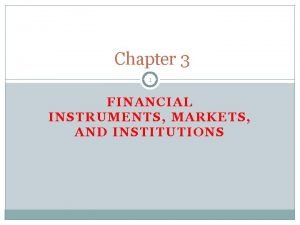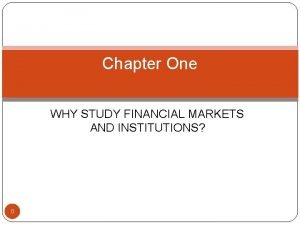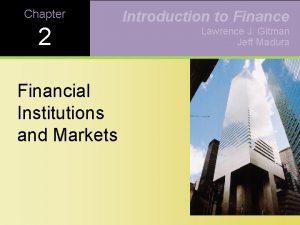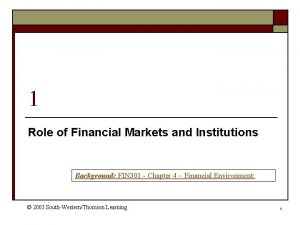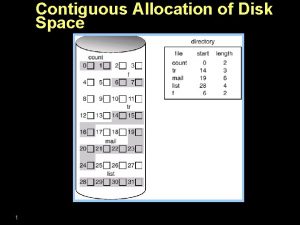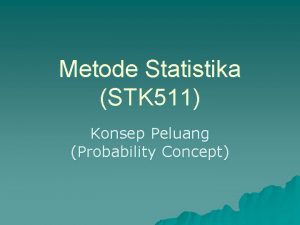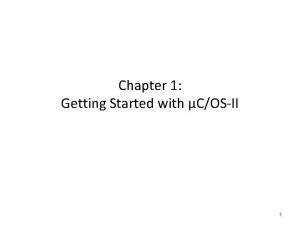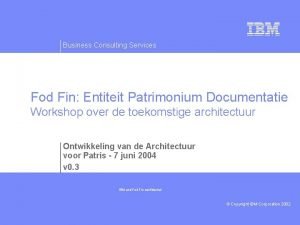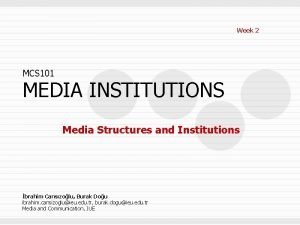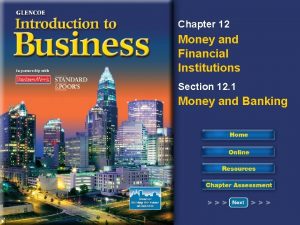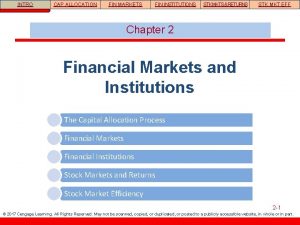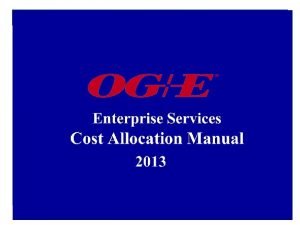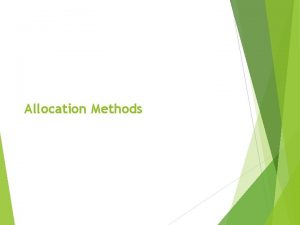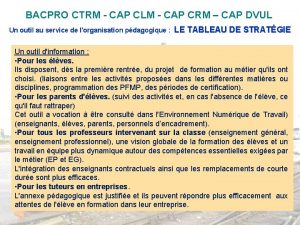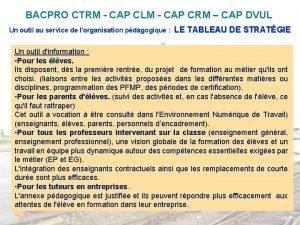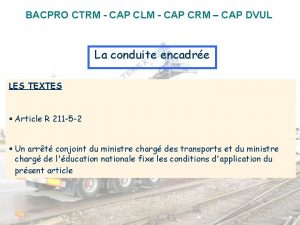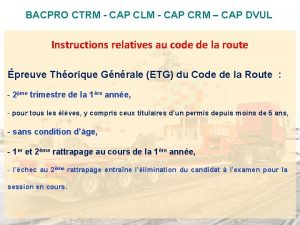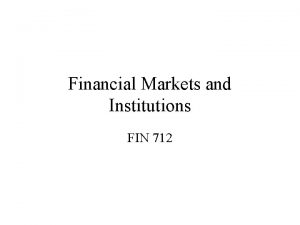INTRO CAP ALLOCATION FIN MARKETS FIN INSTITUTIONS STK






















- Slides: 22

INTRO CAP ALLOCATION FIN MARKETS FIN INSTITUTIONS STK MKTS & RETURNS STK MKT EFF HOW IS CAPITAL TRANSFERRED BETWEEN SAVERS AND BORROWERS? • Direct transfers • Investment banks • Financial intermediaries 2 -1


INTRO CAP ALLOCATION FIN MARKETS FIN INSTITUTIONS STK MKTS & RETURNS STK MKT EFF TYPES OF FINANCIAL MARKETS • • • 2 -3 Physical assets vs. Financial assets Spot vs. Futures Money vs. Capital Primary vs. Secondary Public vs. Private

INTRO CAP ALLOCATION FIN MARKETS FIN INSTITUTIONS STK MKTS & RETURNS STK MKT EFF TYPES OF FINANCIAL INSTITUTIONS • Investment banks • Commercial banks (http: //www. marketwatch. com/investing/stock/bac/financials/bal ance-sheet) • Credit unions • Pension funds • Life insurance companies • Mutual funds (www. fidelity. com) • Exchange traded funds (http: //www. etf. com/etfanalytics/etffinder) • Hedge funds (http: //marketplace. publicradio. org/display/web/2008/ 12/15/whiteboard_a_look_inside_hedge_funds/) 2 -4

INTRO CAP ALLOCATION FIN MARKETS FIN INSTITUTIONS STK MKTS & RETURNS STK MKT EFF WHAT IS AN IPO? • An initial public offering (IPO) occurs when a company issues stock in the public market for the first time. • “Going public” enables a company’s owners to raise capital from a wide variety of outside investors. Once issued, the stock trades in the secondary market. • Public companies are subject to additional regulations and reporting requirements. 2 -5

INVESTMENT BANKING PROCESS

VONTAGE EXAMPLE 2 -7

BALANCE SHEET • The balance sheet is a snapshot of the firm’s assets and liabilities at a given point in time • Assets are listed in order of decreasing liquidity § Ease of conversion to cash § Without significant loss of value • Balance Sheet Identity § Assets = Liabilities + Stockholders’ Equity Copyright © 2016 by Mc. Graw-Hill Global Education LLC. All rights reserved. 2 -8

THE BALANCE SHEET FIGURE 2. 1 Copyright © 2016 by Mc. Graw-Hill Global Education LLC. All rights reserved. 2 -9

NET WORKING CAPITAL AND LIQUIDITY • Net Working Capital § = Current Assets – Current Liabilities § Positive when the cash that will be received over the next 12 months exceeds the cash that will be paid out § Usually positive in a healthy firm • Liquidity § Ability to convert to cash quickly without a significant loss in value § Liquid firms are less likely to experience financial distress § But liquid assets typically earn a lower return § Trade-off to find balance between liquid and illiquid assets Copyright © 2016 by Mc. Graw-Hill Global Education LLC. All rights reserved. 2 -10

U. S. CORPORATION BALANCE SHEET TABLE 2. 1 Copyright © 2016 by Mc. Graw-Hill Global Education LLC. All rights reserved. 2 -11

MARKET VALUE VS. BOOK VALUE • The balance sheet provides the book value of the assets, liabilities, and equity. • Market value is the price at which the assets, liabilities, or equity can actually be bought or sold. • Market value and book value are often very different. Why? • Which is more important to the decision-making process? Copyright © 2016 by Mc. Graw-Hill Global Education LLC. All rights reserved. 2 -12

EXAMPLE 2. 2 KLINGON CORPORATION Copyright © 2016 by Mc. Graw-Hill Global Education LLC. All rights reserved. 2 -13

INCOME STATEMENT • The income statement is more like a video of the firm’s operations for a specified period of time. • You generally report revenues first and then deduct any expenses for the period • Matching principle – GAAP says to show revenue when it accrues and match the expenses required to generate the revenue Copyright © 2016 by Mc. Graw-Hill Global Education LLC. All rights reserved. 2 -14

U. S. CORPORATION INCOME STATEMENT – TABLE 2. 2 Copyright © 2016 by Mc. Graw-Hill Global Education LLC. All rights reserved. 2 -15

WORK THE WEB EXAMPLE • Publicly traded companies must file regular reports with the Securities and Exchange Commission • These reports are usually filed electronically and can be searched at the SEC public site called EDGAR • Click on the web surfer, pick a company, and see what you can find! Copyright © 2016 by Mc. Graw-Hill Global Education LLC. All rights reserved. 2 -16

TAXES • The one thing we can rely on with taxes is that they are always changing • Marginal vs. average tax rates § Marginal tax rate – the percentage paid on the next dollar earned § Average tax rate – the tax bill / taxable income § Average tax rates vary widely across different companies and industries • Other taxes Copyright © 2016 by Mc. Graw-Hill Global Education LLC. All rights reserved. 2 -17

EXAMPLE: MARGINAL VS. AVERAGE RATES • Suppose your firm earns $4 million in taxable income. § What is the firm’s tax liability? § What is the average tax rate? § What is the marginal tax rate? • If you are considering a project that will increase the firm’s taxable income by $1 million, what tax rate should you use in your analysis? Copyright © 2016 by Mc. Graw-Hill Global Education LLC. All rights reserved. 2 -18

THE CONCEPT OF CASH FLOW • Cash flow is one of the most important pieces of information that a financial manager can derive from financial statements • The statement of cash flows does not provide us with the same information that we are looking at here • We will look at how cash is generated from utilizing assets and how it is paid to those that finance the purchase of the assets Copyright © 2016 by Mc. Graw-Hill Global Education LLC. All rights reserved. 2 -19

CASH FLOW FROM ASSETS • Cash Flow From Assets (CFFA) = Cash Flow to Creditors + Cash Flow to Stockholders • Cash Flow From Assets = Operating Cash Flow – Net Capital Spending – Changes in NWC Copyright © 2016 by Mc. Graw-Hill Global Education LLC. All rights reserved. 2 -20

EXAMPLE: U. S. CORPORATION – PART I • OCF (I/S) = EBIT + depreciation – taxes = $547 • NCS (B/S and I/S) = ending net fixed assets – beginning net fixed assets + depreciation = $130 • Changes in NWC (B/S) = ending NWC – beginning NWC = $330 • CFFA = 547 – 130 – 330 = $87 Copyright © 2016 by Mc. Graw-Hill Global Education LLC. All rights reserved. 2 -21

EXAMPLE: U. S. CORPORATION – PART II • CF to Creditors (B/S and I/S) = interest paid – net new borrowing = $24 • CF to Stockholders (B/S and I/S) = dividends paid – net new equity raised = $63 • CFFA = 24 + 63 = $87 Copyright © 2016 by Mc. Graw-Hill Global Education LLC. All rights reserved. 2 -22
 Financial markets and institutions - ppt
Financial markets and institutions - ppt Madura j. financial markets and institutions
Madura j. financial markets and institutions Basic flow of funds through the financial system
Basic flow of funds through the financial system Why study financial markets and institutions
Why study financial markets and institutions Why study financial markets and institutions
Why study financial markets and institutions Madura j. financial markets and institutions
Madura j. financial markets and institutions Financial intermediaries ppt
Financial intermediaries ppt Equity securities
Equity securities Linked allocation
Linked allocation Financial markets and the allocation of capital
Financial markets and the allocation of capital Beregning af golfhandicap
Beregning af golfhandicap Cap compas cap vrai
Cap compas cap vrai Stk nedir
Stk nedir Seeaé
Seeaé Stk-8
Stk-8 Contoh nilai stk
Contoh nilai stk Stk
Stk Stk nedir
Stk nedir Omnibus ii stk
Omnibus ii stk Spf fin fod fin
Spf fin fod fin Fin fin
Fin fin Media institutions definition
Media institutions definition Chapter 12 money and financial institutions
Chapter 12 money and financial institutions


